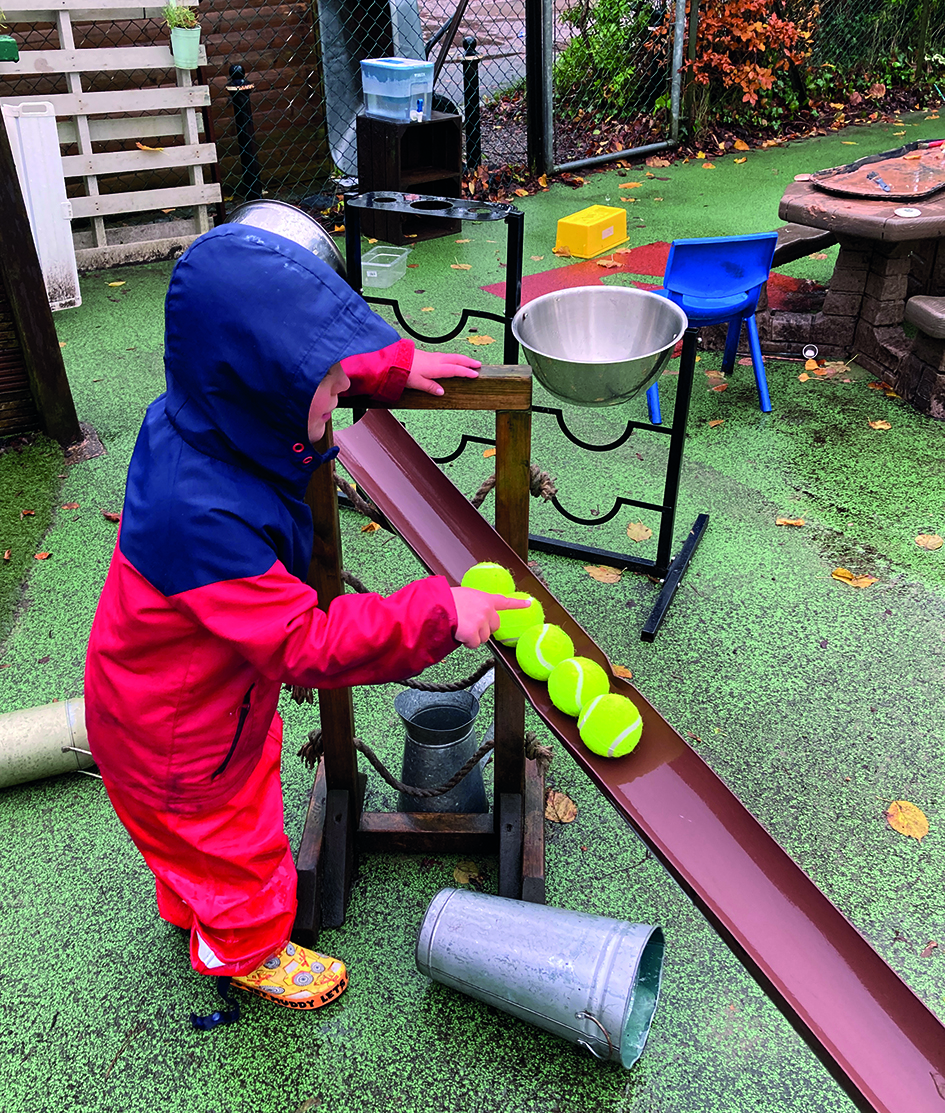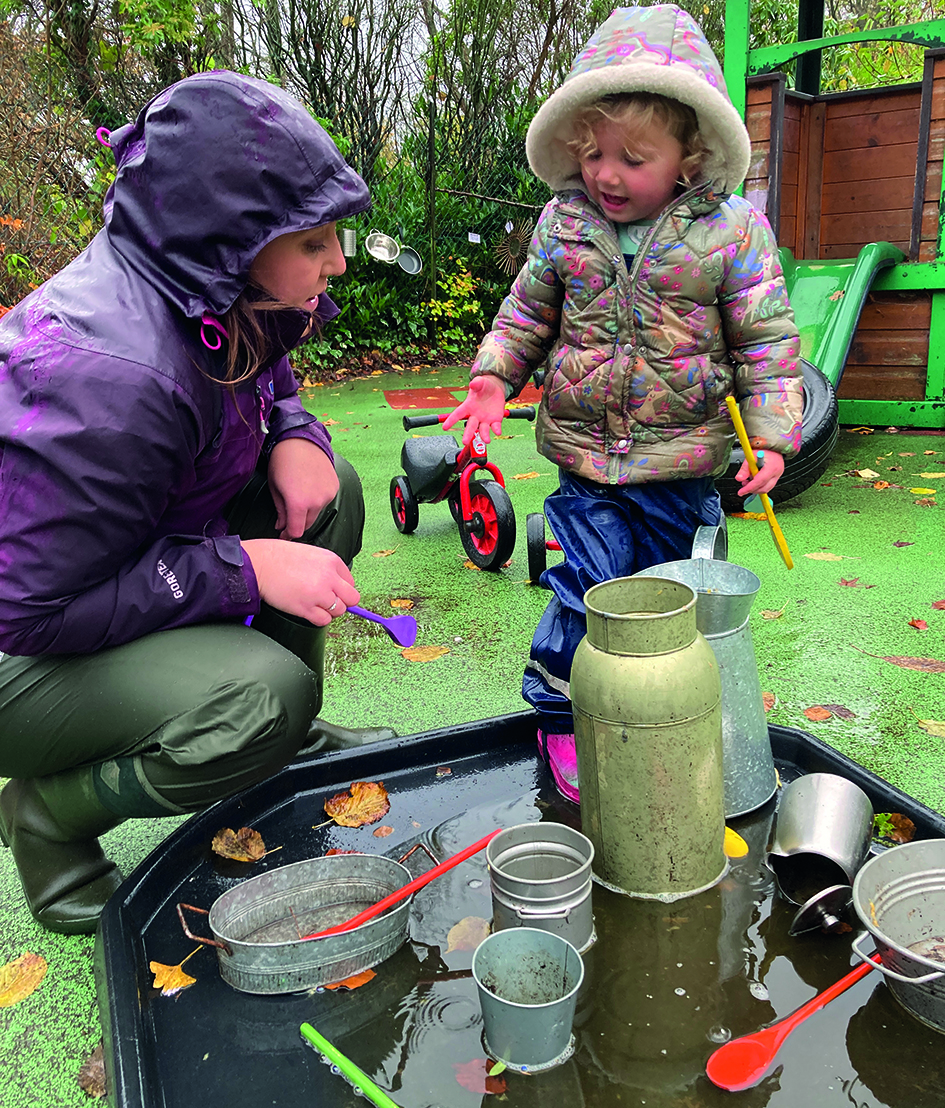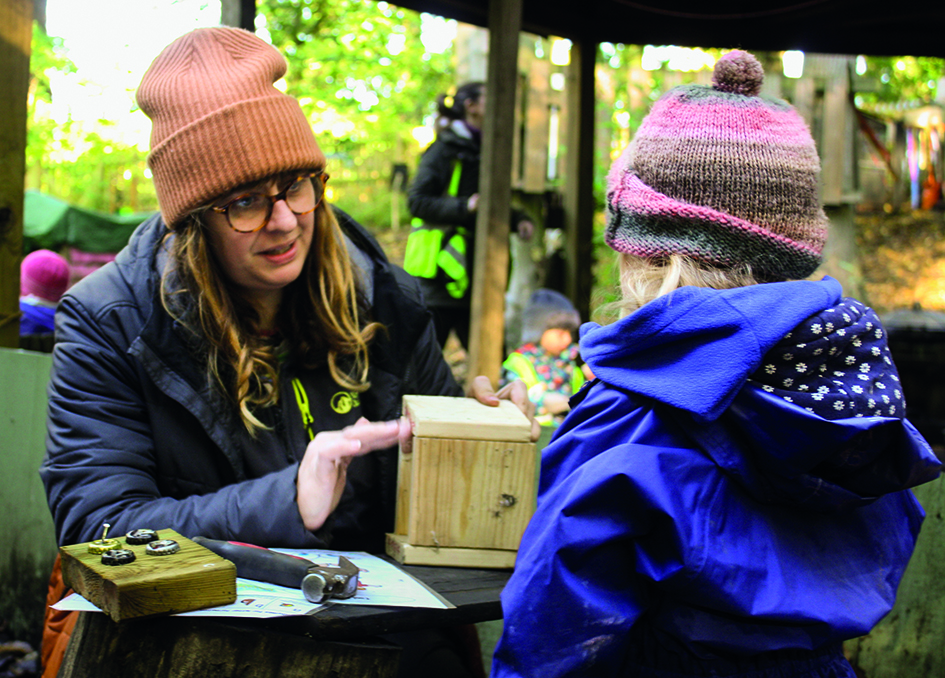
Fire circle time is great for developing communication and listening skills, and we use this time to introduce and reinforce other areas of learning, too,’ Emma Harwood, co-founder and co-director at Dandelion Education told me. ‘We might use phonic clues to support children to work out what's in the day's Mystery Box; we immerse children in text as we tell or read the same story every day over a couple of weeks. Even our youngest are involved in our lunchtime Philosophy for Children discussions.’
 There are many reasons for developing a high-quality outdoor space for young children, but arguably the main one is to ensure children are able to access a rich and compelling play-based curriculum throughout the setting. At each of the award-winning settings I observed evidence of a robust curriculum offer: for me, a truly enabling outdoor environment gives children endless opportunities for STEM learning – or better still, STEAM (the A stands for Arts).
There are many reasons for developing a high-quality outdoor space for young children, but arguably the main one is to ensure children are able to access a rich and compelling play-based curriculum throughout the setting. At each of the award-winning settings I observed evidence of a robust curriculum offer: for me, a truly enabling outdoor environment gives children endless opportunities for STEM learning – or better still, STEAM (the A stands for Arts).
At Kids Planet Stretton, children were discovering the effects of gravity with water and tennis balls. Will noticed that if he pushed a tennis ball down the guttering with more force, it moved more quickly and caught up with the ones he had just released. Keyworker Heather Kennedy encouraged him to try it with the plastic ‘ball pit’ balls to see if the same thing would happen. ‘Is it getting faster?’ Heather asked Will. ‘No,’ he replied, puzzled, ‘I can't make it go.’ I wondered if more water poured down the gutter would help, so he refilled the bucket – and discovered that really sploshing the water into the gutter did indeed make the balls move quicker.
At Beatle Woods and Dandelion, both fully outdoor settings, practitioners combined ‘in the moment’ planning with organised sessions with key children – I watched a boy exploring phonemes and digraphs at Dandelion through talking about and playing with a wooden train he had made himself (see Case study).
COMMUNICATION
 With so much to see and test, children's urge to share is almost overwhelming, and in each setting, communication took many forms. Plenty of children were chatty and excited to share their play with me, but others took my hand to point out their favourite places, some hummed along with their play, others made marks in the mud or on fences to claim ownership, and children's joy in being outdoors was communicated most clearly through their bodies.
With so much to see and test, children's urge to share is almost overwhelming, and in each setting, communication took many forms. Plenty of children were chatty and excited to share their play with me, but others took my hand to point out their favourite places, some hummed along with their play, others made marks in the mud or on fences to claim ownership, and children's joy in being outdoors was communicated most clearly through their bodies.
At Ashbridge Nursery, two toddlers crouched next to a hole they had dug at the base of a tree, minutely examining the soil, the bark, the minibeasts they found: ‘dirt… stick… pick it up [a woodlouse]… be gentle… deep, dig more deep…’ Excited shouts of ‘acorns! Acorrrrrrrns!’ reverberated around the forest as half a dozen children found a stash that other children had hidden the day before. ‘Moving from two hours of time in the forest area to a whole day for each class has made a huge difference to what children do,’ forest leader Kylie Lower told me. ‘It gives them so much more time to explore and learn, and we get more moments to teach environmental concepts like the seasons and life cycles, and help children use “real” scientific words to describe what they're finding. Plus, you can really see the switch from indoors as the quietest children suddenly find their voices when they have all this space to play in.’
Children playing in the rain at Kids Planet Stretton had much to explain, talking about:
- big puddles – ‘It's so wet, it's splashed on my head!’
- the willow structure – me: ‘Where's the best place to hide in the garden?’; Abigail: ‘This [the willow dome] is the best place’; me: ‘But there's hardly any leaves on it…’; Abigail: ‘Well, not every day…’
- their impressions of the enormous trees in the garden next door – ‘We're allowed to go under that tree but it's too big to climb up.’
- a cocktail maker of the future – ‘We're making potions…’
The arrival of a parent in a police car sparked enormous interest at Beatle Woods. Children considered its colours and its size (would it fit through the gates?), asked politely to climb in and laughed and danced around it.
CASE STUDY: toymaking at Dandelion
 Dandelion co-founder Hayley Room says, ‘We don't provide toys, as toys are quite closed. If a child wants a car, we have the tools to make a car. The child would have a conversation with an adult and work together, using gross and fine motor skills and spatial awareness, and test it. That's all the areas of learning.
Dandelion co-founder Hayley Room says, ‘We don't provide toys, as toys are quite closed. If a child wants a car, we have the tools to make a car. The child would have a conversation with an adult and work together, using gross and fine motor skills and spatial awareness, and test it. That's all the areas of learning.
‘We have tools like saws and hammers. They use pieces of wood and things like bottle tops, as we're big on recycling. Children don't just make resources – they make structures they play on. One was a climbing platform. Our children's problem-solving is really amazing – coming up with ideas about how to move the stage.
‘We take a questioning approach. A child might want to make something. If it doesn't work, we say it is OK to make a mistake. We noticed when we teach in primary that children were very fearful of putting their hand up and making a mistake. We might suggest things – can you put this there? Or we might call friends over and say “how can we fix this problem?” We try things out until we find the solution.’
Eco early years
 Perhaps unsurprisingly, all these settings with high-quality, effective outdoor spaces also had eco-friendly measures. Ideas I noted included:
Perhaps unsurprisingly, all these settings with high-quality, effective outdoor spaces also had eco-friendly measures. Ideas I noted included:
- Water saving and reusing: water butts on sheds and playhouses as well as on the building, allowing planting to be watered without using fresh water; push-taps for drinking water to avoid dispensing more than is needed; hose pipes with clutch triggers to limit overspills. Children still had access to water for play, but adult awareness of how precious water is meant conserving it was ‘normalised’ for the children.
- Food crops: children learning how to grow food from scratch, from herbs and salads in Kids Planet's small urban garden through to greenhouses at Ashbridge's large rural site. Holmsdale Manor is going organic and has a small orchard and allotment, with children working alongside a gardener to tend crops.
- Nature immersion: children were helped to develop an understanding of the natural world and their place in it through access to natural materials for play and Forest School or excursions to local parks. Environmentalists widely agree that for children to grow up determined to care for and improve the environment, they must first experience and appreciate it.
- Energy use: the outdoor settings, Beatle Woods and Dandelion, operated with a very low-energy impact, often relying on just an open fire for heating and cooking – although both did have alternative sources of heat when needed. Children were really well wrapped up when I visited on a cold and damp day and staying active helped keep them warm.
- Waste: in common with many settings, the award-winners were also addressing the amount of waste. Several were reducing or cutting out the use of plastic for food serving and play resources, disposable wipes and nappies were being swapped for reusable, and at Holmsdale Manor I spotted their site caretaker taking play resources off for repair in a dedicated on-site workshop.
- Reduce, reuse, recycle: the magic of loose parts was showcased – I wrote about this in more detail last month. Many of these items made use of objects that might otherwise have ended up in landfill – crates, pieces of timber, cable reels and pallets, cotton reels, ropes and even an old boat.









